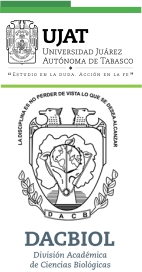FRESHWATER ROTIFER: (PART II) A LABORATORY STUDY OF NATIVE FRESHWATER ROTIFERS Brachionus angularis AND B. quadridentatus brevispinus FROM TABASCO
DOI:
https://doi.org/10.19136/kuxulkab.a18n35.255Resumen
This study is a first report of rotifer form the South of Mexico. The rotifers were collected from the fishponds arround Biological Division, UJAT and we examined their morphometric characters, cultivated and identified them. We conducted experiment at different salt concentrations tested at 0g L–1 water (no add NaCL), 2g L–1, 4g L–1, 6g L–1, 8g L–1, 10g L–1 water. The species were identified as Brachionus angularis Gosse (1851) characterized by having two anterior spines, which are almost invisible while B. quadridentatus brevispinus Ehrenberg (1832) with six anterior spines, which can be seen clearly. Lorica size of B. angularis and B. quadridentatus brevispinus are about 12.14 and 12.8 m, respectively and the size is much smaller than B. plicatilis (Mazatlan strain).Descargas
Referencias
Ajah, P. 2010. Mass culture of Rotifera “Brachionus quadridentatus” (Hermann, 1783) using three different algal species. African Journal of Food Science, 4(3): 80-85.
Ara, K. 2002. Temporal variability and production of “Temora turbinata” (Copepoda: Calanoida) in the Cananéia Lagoon estuarine system, São Paulo, Brazil. Scientia Marina, 66(4): 399-406.
Arimoro, F.O. 2006. Culture of the freshwater rotifer, “Brachionus calyciflorus”, and its application in fish larviculture technology. African Journal of Biotechnology, 5(7): 536-541.
Alva-Martınez; Rocio Fernandez; S.S.S. Sarma, & S., Nandini. 2009. Effect of mixed toxic diets (Microcystis and Chlorella) on the rotifers “Brachionus calyciflorus” and “Brachionus havanaensis” cultured alone and together. Limnologica, 39: 302-305.
Campos-Ramos, R.; Maeda-Martinez, A.M.; Obregon Barboza, H.; Murugan, G.; Guerrero-Tortolero; D.A. & Monsalvo-Spencer, P. 2003. Mixture of parthenogenetic and zygogenetic brine shrimp Artemia (Branchiopoda: Anostraca) in commercial cyst lots from Great Salt Lake, UT, USA. J. Exp. Mar. Biol. Ecol., 296: 243-251.
Dahril, T. 1997. A study of the freshwater rotifer “Brachionus calyciflorus” in Pekanbaru, Riau, Indonesia. Hydrobiologia, 358: 211-215.
Derry, A.M.; Prepas, E.E. & Hebert, P.D.N. 2003. A comparison of zooplankton communities in saline lakewater with variable anion composition. Hydrobiologia, 505(1): 199-215.
Epifano, C.E. & Garvine, R.W. 2001. Larval transport on the Atlantic Continental Shelf of North America: a review. Estuarine, Coastal and Shelf Science, 52(1): 51-77.
Fu, Y.; K. Hirayama & Y. Natsukari. 1991. Morphological differences between two types of the rotifer “Brachionus plicatilis”. O. F Muller. J Exp. Mar. Biol. Ecol., 151: 29-42.
Fujita, S. 1979. Culture of red sea bream, Pagrus major, and its food. In: Cultivation of Fish Fry and Its Live Food. E. Styczynska-Jurewics, T. Backiel, E. Jaspers and G. Persoone (eds). European Mariculture Society, Special Publication, 4: 183-197.
Fontaneto, F.; Smeth, W.H. & Ricci, C. 2006. Rotifers in saltwater environments, re-evaluation of an inconspicuous taxon. Journal of the Marine Biological Association of the United Kingdom, 86(4): 623-656.
Hagiwara, A.; T. Kotani.; T.W. Snell.; M. Snell.; M. Assava-Aree & K. Hirayama. 1995. Morphology, reproduction and genetics of the tropical minute marine rotifer Brachionus starins. J. Exp. Mar. Biol. Ecol., 194: 25-37.
Hammer, U.T. 1993. Zooplankton distribution and abundance in saline lakes of Alberta and Saskatchewan, Canada. International Journal of Salt Lake Research, 2(2): 111-132.
Herbst, D.B. 2001. Gradients of salinity stress, environmental stability and water chemistry as a templet for defining habitat types and physiological strategies in inland salt waters. Hydrobiologia, 466(1): 209-219.
Hirata, H. 1979. Rotifer culture in Japan. Spec. Publ. Eur. Maricult. Soc., 4: 361-375.
Hoff, F.H. & T.W. Snell. 1999. Plankton Culture Manual. Ed. Jeffrey Neslen. Fifth Edition. Florida Aqua Farms, Inc. 160 p.
Kafuku, T. & H. Ikenoue (eds). 1983. Modern Methods of Aquaculture in Japan. Elsevier and Kodansha Ltd, Tokyo.
Keler, W. & Conlin, M. 1994. Crustacean zooplankton communities and lake morphometry in Precambrian Shield lakes. Canadian Journal of Fisheries and Aquatic Sciences, 51(11): 2424-2434.
Lansac-Tôha, F.A. & Lima A.F. 1993. Ecologia do zooplâncton do estuário do rio Una do Prelado (São Paulo, Brasil). Acta Limnologica Brasiliensia, 6(1): 82-96.
Lubsenz, E. 1987. Raising rotifer for use in aquaculture. Hydrobiologia, 147: 245-255.
Lubzens, E.; A. Tandler & G. Minkoff. 1989. Rotifers as food in aquaculture. Hidrobiologia, 186/187: 387-400.
Ludwig, G.M. 1993. Effect of Trichlorfon, Fenthion, and Diflubenzuron on the zooplankton community and on the production of the reciprocal-cross hybrid striped bass fry in culture ponds. Aquaculture, 110: 301-319.
Martınez-Palacios C.A.; Morte J.C.; Tello-Ballinas J.A.; Toledo-Cuevas M.; Ross L.G. 2004. The effects of saline environments on survival and growth of eggs and larvae of Chirostoma estor estor Jordan 1880 (Pisces: Atherinidae). Aquaculture, 238: 509-522.
Miracle, M.R. & M. Serra. 1989. Salinity and temperature influence in rotifer life history characteristics. Hydrobiologia, 186/187: 81-102.
Mustahal T.; Yamasaki S. & Hirata H. 1991. Salinity adaptability of five different strains of the rotifer “Brachionus plicatilis”. Jpn. Soc. Sci. Fish., 57: 1997-2000.
Okauchi, M., T. Ossiro, S. Kitamura, A. Tsujogado & K. Fukusho. 1980. Number of rotifer, Brachionus plicatilis, consume dily by a larva and juvenile of pogy, “Acanthopagrus schlegeli”. Bull. Nat. Res. Inst. Aqu., 1: 39-45.
Onwudinjo, C.C. & Egborge, A.B.M. 1994. Rotifers of Benin River, Nigeria. Hydrobiologia, 272(1): 87-94.
Park H.G, K.W.Lee, S.H.Cho, H.S. Kim, M.Jung and H.S. Kim. 2001. High density culture of the freshwater rotifer, Brachionus calyciflorus. Hydrobiologia, 446/447:369-374.
Peredo-Alvarez V.M.; Sarma S.S.S. & Nandini, S. 2003. Combined effect of concentrations of algal food (Chlorella vulgaris) and salt (sodium chloride) on the population growth of “Brachionus calyciflorus” and “Brachionus patulus” (Rotifera). Rev Biol Trop., 51: 399-408.
Remane, A. & Schlieper, C. 1971. The biology of brackish waters. New York: Wiley Interscience. 372 p.
Shiri, H.A.; A. Charley.; J. Auwerx.; J. Vught.; J. Slycken.; P. Dhert. & P. Sorgeloos. 2003. Larval rearing of burbot “Loto lota” using “Barchionus calyciflorus” as a starter food. J. Appl. Ichthyol., 19(2): 84-87.
William, W.D. 1998. Salinity as a determinant of the structure of biological communities in salt lakes. Hydrobiologia, 381(6): 191-201.
Zakaria, H.Y.; Radwam, A.A. & Said, M.A. 2007. Influence of salinity on zooplankton community in El-Mex Bay, Alexandria, Egypt. Egyptian Journal of Aquatic Research, 33(3): 52-67.
Descargas
Publicado
Número
Sección
Licencia
Los autores que publiquen en Kuxulkab' aceptan las siguientes condiciones como política de acceso abierto:
1. Que conservan los derechos de autor y ceden a la revista el derecho de la primera publicación, con el trabajo registrado con la licencia de atribucion de "Creative Commons", que permite a terceros utilizar lo publicado siempre que mencionen la autoría del trabajo y a la primera publicación en esta revista.
2. El autor puede realizar otros acuerdos contractuales independientes o adicionales para la distribución no exclusiva de la versión del artículo publicado en esta revista, como por ejemplo incluirlo en un repositorio institucional o publicarlo en un libro, siempre que se indique claramente que el trabajo se publicó por primera vez en esta revista.













